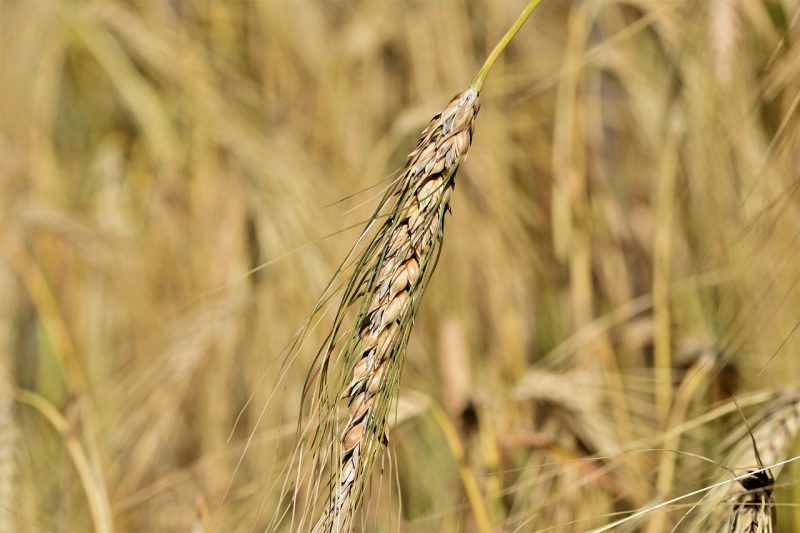I honestly did not know that things were this bad. Severe drought is crippling winter wheat production in the middle of the country, agricultural production in many areas of California is being hit extremely hard by unprecedented flooding, and orange production in Florida is down more than 60 percent from last season due to a combination of factors. Of course this comes at a time when the entire world is dealing with a major food crisis. As I discussed in a previous article, even CNN is admitting that we are currently in the midst of “the worst food crisis in modern history”. So this is a year when we need U.S. food production to be very strong, and that simply is not happening.
No state produces more winter wheat than Kansas does, and right now less than 20 percent of the winter wheat in the state “is in good to excellent condition”…
Less than 20 percent of Kansas winter wheat is in good to excellent condition. The U.S. Drought Monitor says only 15 percent of Kansas’ acres are not experiencing any level of drought stress. More than 36 percent of the state reported D4 exceptional drought compared to just a little over one percent last year. D3 extreme drought conditions are hurting 16 percent of the state, with D2 severe drought hitting 13 percent of Kansas.
Unfortunately, the winter wheat in other crucial states is also greatly suffering due to seemingly endless drought conditions…
Colorado winter wheat was rated 27% good to excellent and 33% very poor to poor. Oklahoma’s and Texas’ crops were rated at 26% and 18% good to excellent, and 40% and 47% very poor to poor, respectively, he said.
This is really bad news.
Wheat prices just continue to escalate, and that is especially true for hard-red winter wheat…
The spread between hard-red winter wheat and soft-red winter wheat has blown out to a record high as drought threatens crop yields across the Midwest and other major farming regions.
Hard-red winter wheat’s premium over soft-red winter wheat is $1.72 a bushel in Chicago on Tuesday morning, surpassing the 2011 record.
Meanwhile, the outlook for spring wheat is not particularly promising, because U.S. farmers have planted the smallest amount of spring wheat since 1972.
Out on the west coast, too much water is the problem.
In fact, 78 trillion gallons of water has fallen on the state of California in recent months…
More than a dozen powerful storms later, 78 trillion gallons of water has been dumped on California, reversing a multi-year drought in a matter of months. Now the agricultural powerhouse state, producing about a third of the country’s vegetables and three-quarters of its fruits and nuts, faces planting delays due to washed-out fields.
When it comes to fruit and vegetable production, no other state even comes close to California, and so we should be greatly alarmed that farms all over the state look like swamps at this moment.
This small farm area in #California just a bit flooded. #CaliforniaFlooding pic.twitter.com/l03kmasTuz
— Sports Plus (@PrepSportsPlus) March 21, 2023
And this is just the beginning.
The mountains in California are absolutely teeming with unprecedented amounts of snow right now, and when it all starts melting all of that water is going to have to go somewhere…
California’s snowpack levels varied by region, with the Southern Sierra snowpack reaching 300% of its April 1 average and the Central Sierra reaching 237% of its April 1 average, officials said. And the critical Northern Sierra, home to the state’s largest surface water reservoirs, is at 192% of its April 1 average.
On the east coast, the big news is what has happened to Florida orange production.
At this point, it is down a whopping 60.7 percent from last year…
Orange production in Florida is down 60.7 percent from last season, one of the lowest figures since the 1930s, according to US Department of Agriculture estimates.
This drop in production has been caused by citrus greening disease and a very tough hurricane season.
Sadly, there are some farmers that have lost almost all of their oranges…
Vernon Hollingsworth grew up in Florida among his family’s orange trees, recently ravaged by a double whammy of disease and a hurricane that have sent juice prices spiraling and left farmers blinking in disbelief.
On a recent March morning, the fifth-generation farmer drove a pickup truck through the rows in his grove, pointing out the damage from Hurricane Ian last fall such as uprooted trees.
“I lost 95 to 97 percent of my crop,” the 62-year-old told AFP, adding “we’re going to have to rebuild, and we need help to do that.”
On top of everything else, the number of beef cows in the United States has dropped to the lowest level since 1962 because ranchers in the middle of the nation have had to cull their herds due to the historic drought.
U.S. food production has been hit by disasters in the past, but we have never had so many strike in such a short period of time.
And the weather just keeps getting crazier and crazier. In fact, as I write this approximately 70 million Americans are being warned that yet another “multi-state tornado outbreak” is on the way…
Nearly 70 million Americans are bracing for yet another round of powerful storms as a severe system makes its way across the US Tuesday, threatening states from Texas to Michigan.
Set to strike this afternoon, the severe weather will bring damaging winds and potentially tornadoes to states in the already storm-stricken South and Midwest, days after a deadly multi-state tornado outbreak crippled the regions.
Of course all of this is happening in a broader context.
Global food supplies just keep getting tighter and tighter, and the head of the UN World Food Program is warning that “we literally could have hell on earth if we’re not very careful”…
Beasley said WFP was just forced to cut rations by 50% to 4 million people in Afghanistan, and “these are people who are knocking on famine’s door now.”
“We don’t have enough money just to reach the most vulnerable people now,” he said. “So we are in a crisis over the cliff stage right now, where we literally could have hell on earth if we’re not very careful.”
Hopefully food supplies will be funneled to those that desperately need it in the months ahead.
But global hunger has been rising at a very rapid rate in recent years, and it is going to continue to rise.
As I detail in several chapters in my latest book, worldwide famine is inevitable no matter what decisions global leaders make now.
All over the world, topsoil is being depleted at a frightening rate, supplies of raw materials that we use for making fertilizer are becoming extremely tight, and farmland all over the planet is being systematically poisoned by microplastics.
The era of abundant food is ending, and our leaders know this.
But most people in the general population are totally clueless about all of this, and so they have no idea what is coming.
Michael’s new book entitled “End Times” is now available in paperback and for the Kindle on Amazon.com, and you can check out his new Substack newsletter right here.
About the Author: My name is Michael and my brand new book entitled “End Times” is now available on Amazon.com. In addition to my new book I have written six other books that are available on Amazon.com including “7 Year Apocalypse”, “Lost Prophecies Of The Future Of America”, “The Beginning Of The End”, and “Living A Life That Really Matters”. (#CommissionsEarned) When you purchase any of these books you help to support the work that I am doing, and one way that you can really help is by sending copies as gifts to family and friends. Time is short, and I need help getting these warnings into the hands of as many people as possible. I have also started a brand new Substack newsletter, and I encourage you to subscribe so that you won’t miss any of the latest updates. I have published thousands of articles on The Economic Collapse Blog, End Of The American Dream and The Most Important News, and the articles that I publish on those sites are republished on dozens of other prominent websites all over the globe. I always freely and happily allow others to republish my articles on their own websites, but I also ask that they include this “About the Author” section with each article. The material contained in this article is for general information purposes only, and readers should consult licensed professionals before making any legal, business, financial or health decisions. I encourage you to follow me on social media on Facebook and Twitter, and any way that you can share these articles with others is definitely a great help. These are such troubled times, and people need hope. John 3:16 tells us about the hope that God has given us through Jesus Christ: “For God so loved the world, that he gave his only begotten Son, that whosoever believeth in him should not perish, but have everlasting life.” If you have not already done so, I strongly urge you to invite Jesus Christ to be your Lord and Savior today.

